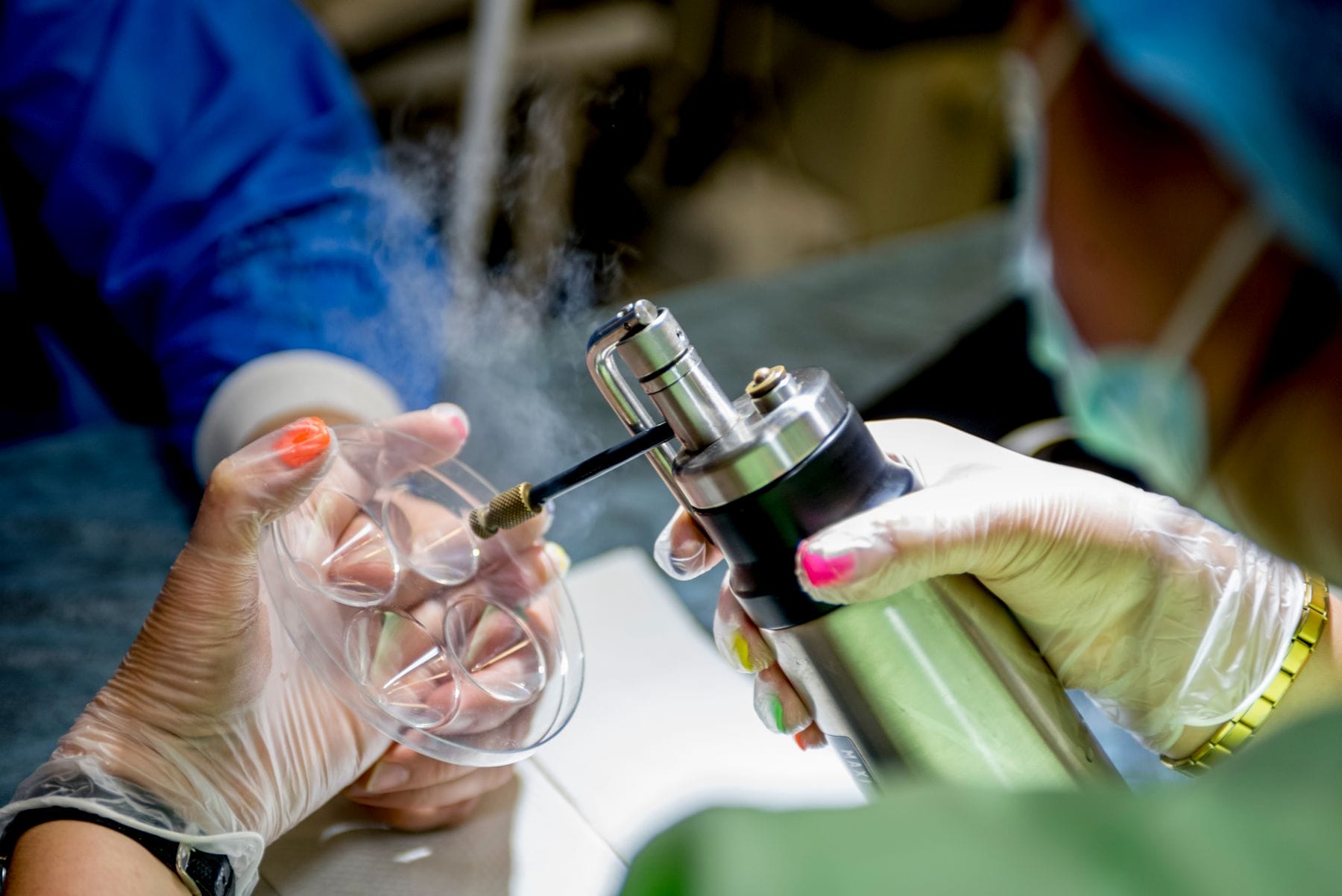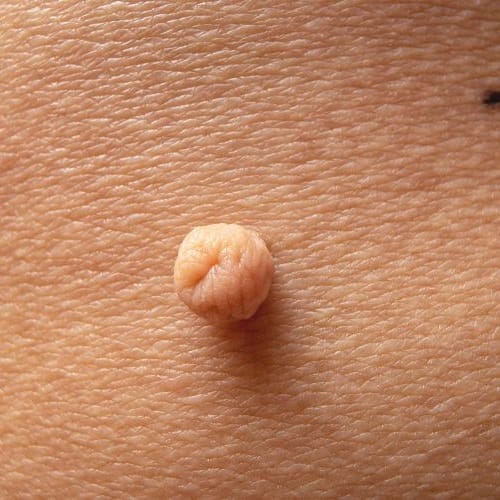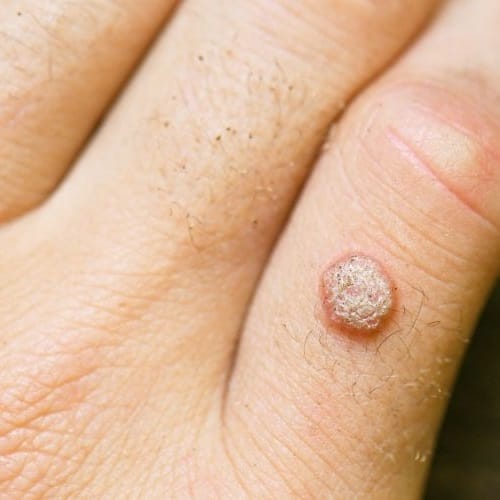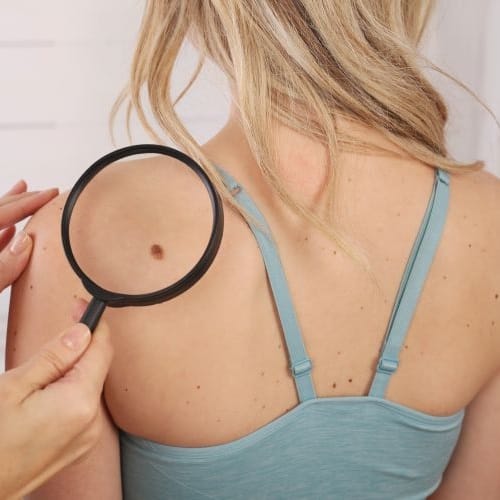Cryotherapy is gaining recognition as a versatile treatment for various skin concerns. This effective procedure can address a range of issues from from skin tags and warts to sun damaged skin.
In this blog, we’ll explore the world of cryotherapy for skin conditions, covering what it is, how it works, the skin issues it can treat, and what results you can expect from this cutting-edge treatment.
What Is Cryotherapy?
Cryotherapy, or cold therapy, is a medical technique that uses extremely cold liquid nitrogen to treat a number of skin problems. It’s a non-invasive procedure available in certain specialist medical clinics.
Cryotherapy can be used for cosmetic purposes, medical treatments, and even as a method to manage skin cancers in certain scenarios.
How Does Cryotherapy for the Skin Work?
To understand how cryotherapy works on your skin, let’s break it down step by step. This procedure uses an ultra-cold substance called liquid nitrogen to target and treat various skin issues effectively. Here’s the science behind it:
- Liquid Nitrogen: It’s incredibly cold, and when applied to your skin, it works like a deep freeze.
- Freezing the Trouble: When you have skin problems like warts, skin tags, or sun damage, the liquid nitrogen is precisely applied to those areas. It’s so cold that it essentially freezes and kills off the problematic skin tissue.
- The Icy Transformation: The frozen tissue begins to die off.
- Natural Healing: Over time, as your skin heals, the frozen tissue naturally sheds away. It’s like Mother Nature’s way of giving your skin a fresh start.

What Skin Issues Can Be Treated with Cryotherapy?
Cryotherapy is effective in addressing a wide range of skin concerns, including:
- Skin Tags: Skin tags are small, benign growths that often appear on the body. Cryotherapy swiftly and painlessly removes these protrusions, resulting in smoother skin.
- Warts and Verrucaes: Whether caused by the human papillomavirus (HPV) or common strains, warts are skin growths. Cryotherapy eliminates warts by freezing the affected tissue, causing them to eventually disappear.
- Sun Damage: Sun damage manifests as various blemishes, including age spots, on the skin due to prolonged sun exposure. Cryotherapy aids in destroying sun-damaged skin, reducing the appearance of these unsightly marks and reducing the risk of future cancerous change.
What Areas of the Body Can Be Treated with Cryotherapy?
Cryotherapy for the skin can safely and effectively be used on many different areas of the body, including:
- Face: Cryotherapy can be used on the face to address issues like skin tags, warts, or sun-damaged areas. It’s a precise and effective way to rejuvenate your facial skin.
- Neck: The neck area is also a common target for cryotherapy, especially when dealing with skin tags or other benign growths.
- Chest: If you have skin concerns on your chest, cryotherapy can be applied here as well. It’s often used to treat sun damage and age spots.
- Back: Skin problems on the back, such as warts, can be effectively treated with cryotherapy. It’s particularly useful when these issues are challenging to reach with other methods.
- Arms and Hands: Cryotherapy can work wonders on the arms and hands, where skin tags or warts may appear.
- Legs and Feet: Skin tags and warts can be bothersome on the lower extremities, commonly used to treat verrucae on the feet. Cryotherapy can be used to target these problems, even in hard-to-reach areas.
- Genital Area: Treatment for genital warts is a sensitive topic and cryotherapy can be a viable option for treating these warts.
- Other Areas: Essentially, cryotherapy can be applied to most parts of the body where skin issues occur. Whether it’s on your elbows, knees, or elsewhere, this treatment offers versatility in addressing a wide range of concerns.



What to Expect from Skin Cryotherapy?
When you opt for skin cryotherapy, it’s natural to wonder about the outcomes. The results can vary depending on the specific skin issue you’re addressing, but here are some general expectations:
You’ll experience minimal discomfort during the procedure as cryotherapy is generally well-tolerated. The best part? Cryotherapy sessions are often short, so it’s a convenient choice for those with busy schedules.
Plus, it’s non-invasive, meaning no anaesthetic, cutting or stitches are involved, reducing the risk of scarring. The icing on the cake is its effectiveness – cryotherapy boasts a high success rate in treating a range of skin issues, and the results are often long-lasting. So, you can look forward to smoother, healthier skin without the hassle.
Conclusion
Cryotherapy for the skin is a versatile and effective treatment option for various skin concerns, from cosmetic enhancements to addressing serious conditions like skin cancer.
If you’re considering cryotherapy or have any skin-related questions or issues, MyHealthcare Clinic is here to provide expert guidance and treatments tailored to your needs.
How Can MyHealthcare Clinic Help You?
At MyHealthcare Clinic, our priority is your skin’s health and well-being. Our expert team of doctors specialises in the highly effective treatment of various issues such as skin lesions, tags, and moles using cryotherapy, ensuring you receive the best care possible.
We understand the urgency of addressing skin concerns, which is why we offer same-day freezing treatment using liquid nitrogen for rapid results without unnecessary delays.
With our state-of-the-art medical-grade cryotherapy equipment, which operates at a cooler temperature of -196°C, we provide treatments that are not only more effective but also safer than alternatives like cryopen and histofreeze.
Our commitment to transparency extends to our pricing, ensuring you have clear and affordable options for your cryotherapy needs.
When you choose MyHealthcare Clinic, you’re choosing a dedicated team of professionals focused on helping you achieve healthier skin with care, expertise, and convenience.
Book a consultation with us today.
Frequently Asked Questions
Read our most commonly asked questions about the benefits of cryotherapy for skin:
Cryotherapy for warts involves using liquid nitrogen to freeze the wart. The extreme cold causes the wart’s cells to freeze and die, eventually leading to the wart’s removal. It’s a highly effective method for treating warts, and the frozen tissue will naturally fall off as the skin heals.
Cryotherapy is generally well-tolerated, with most patients experiencing only mild discomfort during the procedure. The discomfort is often brief and manageable. Certain areas of the body, such as the face and ears, can feel more sensitive.
After cryotherapy, you may experience some redness, swelling, and mild discomfort in the treated area. Sometimes the area can crust or blister, before eventually settling. It’s crucial to follow any post-treatment instructions provided by our doctors.
The timeline for results can vary depending on the specific skin issue and individual factors. In many cases, you can expect to see improvement within a few weeks as the treated tissue naturally sheds.
It is highly effective in treating various skin issues, provides minimal discomfort during the procedure, and is quick and convenient for individuals. Cryotherapy is non-invasive, reducing the risk of scarring, and often yields long-lasting results. There is also no specific preparation and patients can walk straight home after treatment. Its versatility allows it to be applied to different body parts, making it a valuable option for addressing skin concerns.
Common side effects of cryotherapy can include redness, crusting, blistering, or temporary skin discolouration at the treatment site. These effects are typically mild and temporary, resolving on their own. Sometimes flat scarring or permanent discolouration can remain.
Most people can resume their regular activities immediately after cryotherapy, including showering and exercising. However, if the treated area is on a highly visible or sensitive part of the body, you may choose to take some time off until any side effects have resolved.
Our doctors will provide specific aftercare instructions based on your treatment. Typically, you’ll be advised to keep the treated area clean and as dry as possible, avoid picking at any scabs or blisters, and use any prescribed topical treatments if necessary. It’s essential to follow these instructions to ensure proper healing and the best results.
Unfortunately, cryotherapy is rarely available on the NHS now, unless you are already under a hospital-based dermatology clinic. They also will not treat benign lesions even if they are troublesome lesions- only sun-damaged skin and skin cancers can be treated.
Therefore, seeking out a reputable specialist medical clinic is often the only means of finding such treatment.
